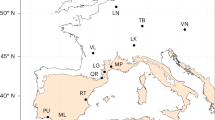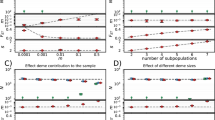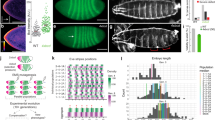Summary
The effective size of a natural Drosophila subobscura population has been computed by drawing together various pieces of ecological information. The value, for both variance and inbreeding effective numbers, is approximately 400. This is largely due to reductions caused by a winter bottleneck and non-random distributions of family sizes.
Areas where such estimates might be refined further are pointed out, and the implications of the results are discussed.
Similar content being viewed by others
Article PDF
References
Basden, E B. 1954. The distribution and biology of Drosophilidae (Dipt.) in Scotland including a new species of Drosophila. Trans roy Soc Edinb, 62, 603–654.
Begon, M. 1976a. Dispersal, density and microdistribution in Drosophila subobscura Collin. J Anim Ecol. (in the press).
Begon, M. 1976b. Temporal variations in the reproductive condition of Drosophila obscura Fallén and D.subobscura Collin. Oecologia (Berl), 23, 31–47.
Begon, M. 1976c. Population densities in Drosophila obscura Fallén and D. subobscura Collin Submitted to Am. Nat.
Crow, J F. 1954. Breeding structure of populations. II. Effective population number. In Statistics and Mathematics in Biology. ed. O. Kempthorne, T. A. Bancroft, J. W. Gowen and J. L. Lush, pp. 543–556. Iowa State Univ. Press, Ames, Ia.
Crow, J F, and Morton, N E. 1955. Measurement of gene frequency drift in small populations. Evolution, 9, 202–214.
Dyson-Hudson, V R D. 1954. The taxonomy and ecology of the British species of Drosophila. D. Phil. dissertation, Oxford University.
Felsenstein, J. 1971. Inbreeding and variance effective number in populations with over-lapping generations. Genetics, 68, 581–597.
Fisher, R A, and Ford, E B. 1947. The spread of a gene in natural conditions in a colony of the moth Panaxia dominula L. Heredity, 1, 143–174.
Greenwood, J J D. 1974. Effective population numbers in the snail Cepaea nemoralis. Evolution, 28, 513–526.
Kimura, M, and Ohta, T. 1971. Theoretical Aspects of Population Genetics. Princeton University Press, Princeton N.J.
Knight, G R. 1960. Structural polymorphism in Drosophila subobscura Collin from various localities in Scotland. Genet Res Camb, 2, 1–19.
Lewontin, R G. 1974. The Genetic Basis of Evolutionary Change. Columbia University Press, New York.
Saura, A, Lakovaara, S, Lokki, J, and Lankinen, P. 1973. Genie Variation in central and marginal populations of Drosophila subobscura. Hereditas, 75, 33–46.
Shorrocks, B. 1975. The distribution and abundance of woodland species of British Drosophila (Diptera: Drosophilidae). J Anim Ecol, 44, 851–864.
Sperlich, D, and Feuerbach-Mravlag, H. 1974. Epistatic gene interaction, crossing over, and linked and unlinked inversions in Drosophila subobscura. Evolution, 28, 67–75.
Wright, S. 1931. Evolution in Mendelian populations. Genetics, 16, 97–159.
Wright, S. 1938. Size of population and breeding strueture in relation to evolution. Science, 87, 430–431.
Wright, S. 1969. Evolution and the Genetics of Populations Volume II The Theory of Gene Frequencies. The University of Chicago Press, Chicago.
Author information
Authors and Affiliations
Rights and permissions
About this article
Cite this article
Begon, M. The effective size of a natural Drosophila subobscura population. Heredity 38, 13–18 (1977). https://doi.org/10.1038/hdy.1977.2
Received:
Issue date:
DOI: https://doi.org/10.1038/hdy.1977.2
This article is cited by
-
Rate of change for the thermal adapted inversions in Drosophila subobscura
Genetica (2019)
-
Monitoring of the genetic structure of natural populations: change of the effective population size and inversion polymorphism in Drosophila subobscura
Genetica (2008)
-
The prospects for polymorphisms shared between species
Heredity (1992)
-
Population dynamics and evolutionary processes: the manifold roles of habitat selection
Evolutionary Ecology (1987)
-
Dispersal and gene flow in a butterfly with home range behavior: Heliconius erato (Lepidoptera: Nymphalidae)
Oecologia (1986)



